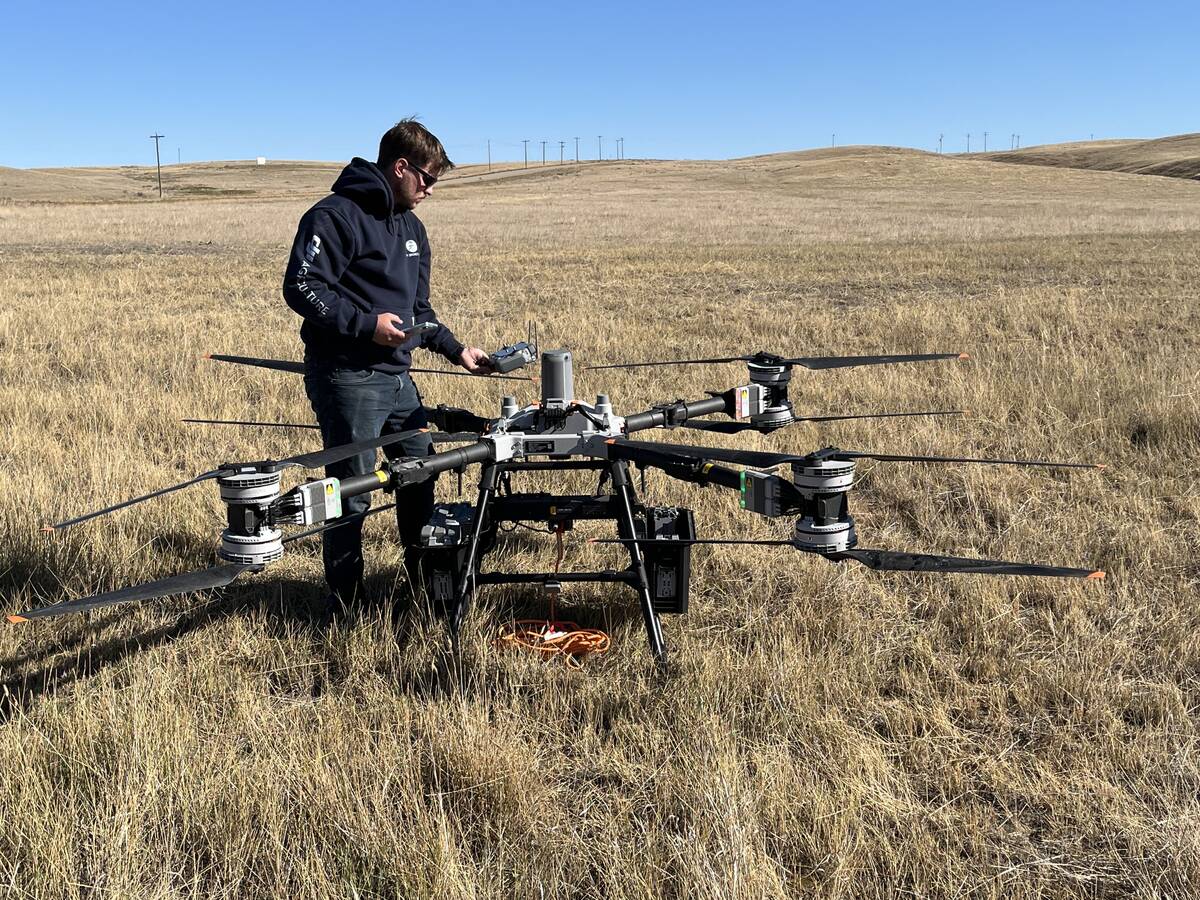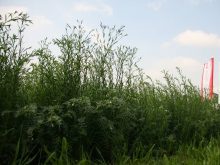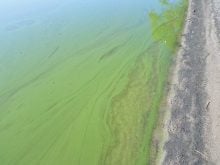While extreme heat and drought made life miserable for farmers in many parts of the Prairies the past few summers, those conditions proved to be something of a silver lining for a group of researchers leading a project called Resilient Rotations.
A key area of the study, which aims to develop a new approach to crop rotations, is comparing precipitation use efficiency among several different types of crop rotations. The comprehensive five-year project is being managed by Western Grains Research Foundations’ Integrated Crop Agronomy Cluster, with research being conducted by Agriculture and Agri-Food Canada (AAFC) and several universities and industry partners at seven field sites in Manitoba, Saskatchewan and Alberta.
Read Also

Farm-facing drone does the heavy lifting
Canadian distributor DJI Agriculture unveils its AGRAS T100 drone to western Canada’s producers for greater efficiencies in spraying and granular spreading in fields.
Sheri Strydhorst, an agronomy consultant in Neerlandia, Alta., and a former research scientist for Alberta Agriculture and Rural Development, is serving as an extension specialist for the project. She says the extreme conditions that affected the Prairies during the study provided researchers with invaluable data.
While the weather made it tough for farmers in Western Canada, Stydhorst says the heat and below normal precipitation turned out to be a “blessing in disguise” for the researchers as it enabled them to study crop rotations under extreme drought conditions. “It doesn’t offset the economic losses in the Prairies due to those low yields with the drought, but it was a silver lining.”
The first phase of the Resilient Rotations study is scheduled to wrap up early this year. It focuses on four key indicators of crop rotation performance:
• Yield
• Economics
• Precipitation use efficiency
• Nitrogen fertilizer use efficiency
A total of six different rotation types were tested in three different areas — the northern and southern Prairie regions in Alberta and Saskatchewan (2018 to 2021) and Manitoba’s Red River Valley (2019 to 2022).
The ultimate aim of the precipitation use efficiency section of the study is to help producers make the most of the precipitation they receive during this time of growing unpredictability around the weather on the Prairies, says Kui Liu, an AAFC research scientist based in in Swift Current, Sask.
A secondary goal was to gain a better understanding of the relationship between precipitation and nutrient use in crops and how the two elements interact.
“If you have nutrients in the soil, the plants’ use of that is limited by how much rainfall they get,” Strydhorst says. “If there isn’t enough rain, they can’t necessarily make use of all of that. It’s kind of a balancing act between the moisture received and the nutrient uptake the plants are able to make use of.”
The research team used precipitation use efficiency (PUE) to compare how efficiently different crop rotations used rainfall. PUE uses the total grain yield produced (expressed as a canola equivalent yield), which is then divided by the rainfall received during that growing season. For example, if a region had a yield of 38 bushels of canola and received 10 inches of rain, the PUE total would be 3.8 bushels of canola per inch of growing season precipitation.
Southern Prairie region
The study’s southern Prairie region consisted of two test sites in Lethbridge, Alta., and Swift Current, Sask. A total of six different fully phased rotations were tested at both locations —control, intensified, diversified, market-driven, high-risk and soil health.
The four-year control rotation consisted of fallow, followed by durum, malt barley and finally durum. The intensified rotation consisted of lentil, durum, chickpea and durum, while the diversified rotation was comprised of lentil, canola, pea and durum.
The market-driven and high-risk rotations varied slightly between the two sites. The market-driven rotation in Swift Current included flax, wheat, lentil and feed barley while its counterpart in Lethbridge contained canola, wheat, wheat and malt barley. The high-risk rotation featured soybean, canary seed, faba bean and durum in Swift Current, with corn substituted for canary seed in Lethbridge. The soil health rotation was forage pea for green manure followed by an intercrop of barley and faba bean, another intercrop of barley and pea and finally durum.
The study results showed that the market-driven and intensified systems had the best PUE ratings in the southern Prairie region. Conversely, the high-risk rotation consistently had the poorest PUE in the region.
Liu believes the strong performance of the market-driven and intensified systems in the southern Prairie region likely had to do with the crops that were selected. He says the pulse crops chosen to be part of the two systems are well adapted to drought conditions, which in turn increased their PUE.
The high-risk rotation had the poorest PUE in the southern Prairie region. Liu says that can be attributed largely to the fact that a lack of rainfall during the study years was more of a limiting factor in the region.
A fallow system that was part of the control rotation also performed poorly in terms of PUE. Liu says that could be an indication that fallow may not be a good practice in the southern Prairie region, even in dry years.
Northern Prairie region
The study’s northern Prairie region consisted of four test sites: Beaverlodge and Lacombe in Alberta and Melfort and Scott in Saskatchewan.

The control rotation at the two Alberta locations included wheat, pea, wheat and canola while the intensified system was comprised of wheat, canola, wheat and canola. The diversified rotation was pea, winter wheat, faba bean and canola. A market-driven rotation consisted of canola, malt barley, canola and canola while the high-risk rotation featured flax, soybean, durum and canola. A soil health mixture was comprised of forage pea for green manure, winter wheat, faba bean and canola.
In Saskatchewan, the control rotation included canola, wheat, pea and wheat while the intensified rotation featured canola, wheat, canola and wheat. A diversified rotation featured pea, winter wheat, faba bean and canola while a market-driven rotation was comprised of oat, canola, wheat and canola in Melfort and canola, canola, green pea and canola in Scott. The high-risk rotation at the two Saskatchewan sites included flax, soybean, durum and canola while the soil health rotation featured forage pea for green manure, winter wheat, faba bean and canola.
One of the more notable results from the northern Prairie region was there wasn’t a consistently better PUE rotation. Liu says part of the reason for that was even though the region was drier than normal during the study, it still received a “decent” amount of rainfall, which in turn produced good yields for most of the rotations.
Another notable result from the northern Prairie region was the soil health rotation having a lower PUE. Strydhorst attributes that to the fact during the green manure phase there was no production. This lowered the overall yield of the rotation, resulting in a significant drop in PUE.
Red River Valley region
The Red River Valley site was located near Carman, Man. It tested a control rotation of wheat, soybean, wheat and canola and an intensified rotation of soybean, wheat, soybean and canola. In addition, a diversified rotation featured canola, winter wheat, soybean and canola while a market-driven rotation was comprised of corn, corn, oat and canola. A high-risk rotation included corn, dry bean, canola and sunflower, while a soil health rotation of green manure, fall rye, corn-soybean and canola-pea intercrops was also tested.
The high-risk and market-driven rotations both demonstrated the best results in terms of PUE. Liu says there were a couple of different reasons for this. Both rotations incorporated corn as part of their crop selections, which helped boost yields. The other reason, he explains, is the Red River Valley has a longer growing season than the other testing sites and received a relatively higher amount of rainfall during the testing period.
Strydhorst says one of the surprises in the Red River Valley region was that traditional crop rotations featuring more wheat and canola didn’t fare better, despite the fact the region averaged 8.7 inches of rain annually during the first phase of the study.
“Maybe it gives producers reason to expand the diversity of rotations in Manitoba, and I think they are doing that with what we see in trends of crop selection data,” she adds.
Liu says one of the common findings from the study was the market-driven rotations tended to have a higher PUE while the high-risk systems tended to have lower PUE ratings at all sites, with the exception of Carman.
While the Resilient Rotations project is expected to wrap up soon, the researchers are hoping to receive funding to extend their research for another five years. Part of the reason for that, Strydhorst explains, is they hope to compile results in more normal or even wetter conditions to provide growers with a more complete picture.
“I think we’ve got some good learnings for drier-than-usual conditions, but I don’t think we could translate this to every year, particularly if we had wetter-than-average conditions,” she says.
















